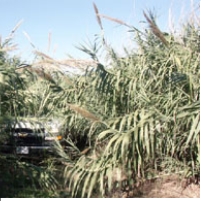Herbicide Spraying in Texas: Border Patrol vs. Locals
 Carrizo cane
Carrizo cane
Residents of Laredo, Texas are objecting to a recent Border Patrol decision to spray the Rio Grande river bank with pesticides, claiming that it has echoes of the Agent Orange scandal of the Vietnam War era. Border patrol officials proposed spraying the herbicide imazapyr from helicopters in order to control the dense carrizo grass that covers vast portions of the Rio Grande river bank and obstructs the Border Patrol's vision of the border crossing. The carrizo cane, which can grow up to 30 feet high at the rapid rate of 4 inches per day, has become an obstacle for the Border Patrol in spotting drug smugglers and immigrants illegally crossing the U.S.-Mexico border. The U.S. Border Patrol planned to begin spraying March 25, but halted operations when the city councils of Laredo and its counterpart city on the other side of the border, Nuevo Laredo, protested the use of the chemical, fearing contamination of their drinking water.
- Top Stories
- Unusual News
- Where is the Money Going?
- Controversies
- U.S. and the World
- Appointments and Resignations
- Latest News
- Musk and Trump Fire Members of Congress
- Trump Calls for Violent Street Demonstrations Against Himself
- Trump Changes Name of Republican Party
- The 2024 Election By the Numbers
- Bashar al-Assad—The Fall of a Rabid AntiSemite






Comments